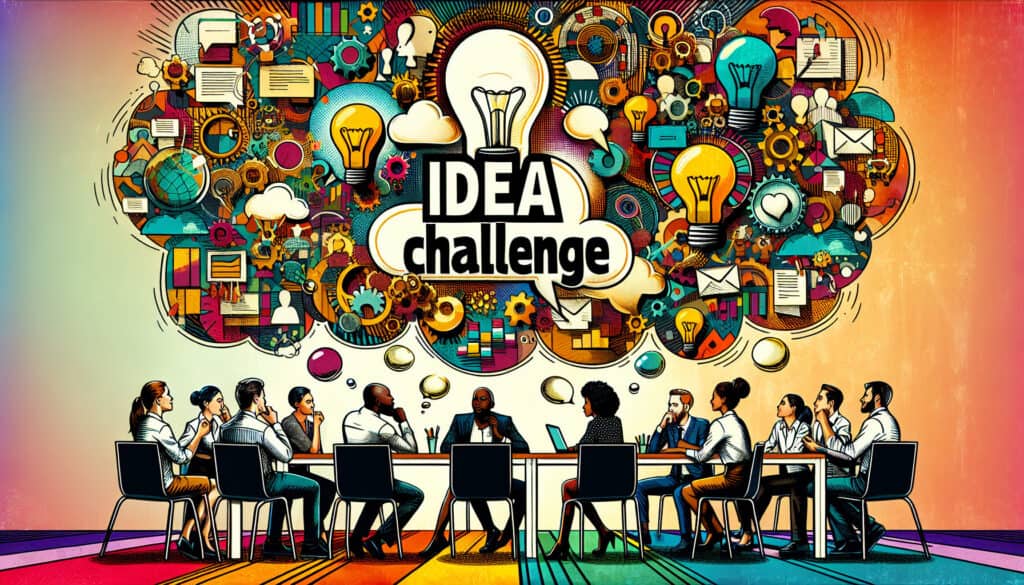To solicit and collect ideas from a large group of people on a specific topic or problem.
- Méthodologies : Clients et marketing, Économie
Défi des idées

Défi des idées
- Méthodologie Agile, Remue-méninges, Créativité, Collaboration interfonctionnelle, Pensée conceptuelle, Idéation, Innovation, Innovation ouverte, User-Centered Design
Objectif :
Comment il est utilisé :
- An event or competition where individuals or teams are invited to submit their ideas on a particular challenge. The best ideas are then selected and rewarded, and may be further developed and implemented.
Avantages
- Can generate a large number of diverse ideas; Can be a great way to s'engager employees or the public.
Inconvénients
- The quality of ideas can be variable; It can be time-consuming to evaluate all the submitted ideas.
Catégories :
- Idéation, Résolution de problèmes
Idéal pour :
- Generating a wide range of ideas on a specific problem or topic from a large and diverse group of people.
The Idea Challenge methodology is frequently applied in industries such as technology, healthcare, education, and consumer goods, where innovation is paramount for staying ahead of competitors. Organizations often leverage this approach during early project phases, such as brainstorming or concept development, inviting employees, partners, and even customers to participate. This inclusivity not only generates a broader range of ideas but also instills a sense of ownership and engagement among participants. For example, tech companies may host an Idea Challenge to crowdsource solutions to a specific software problem, attracting input from software developers, users, and design teams. Similarly, healthcare organizations might seek innovative designs for patient care solutions, engaging professionals from nursing, administration, and even patients themselves. The selection process typically involves criteria related to feasibility, innovation, and alignment with organizational goals, where winning ideas may receive rewards ranging from monetary prizes to opportunities for further funding or implementation within the company. This methodology not only revitalizes the creative process but also serves as a platform for collaboration, facilitating communication among diverse stakeholders and leading to potential partnerships beyond the immediate challenge, thereby cultivating an inventive culture within the organization.
Principales étapes de cette méthodologie
- Define the challenge clearly with specific criteria and goals.
- Launch the idea submission phase, providing a platform for entries.
- Facilitate collaboration or idea refinement among participants.
- Establish a selection committee to evaluate submissions based on predefined criteria.
- Select winning ideas and provide recognition or rewards to the contributors.
- Plan and initiate the development process for the top ideas.
- Encourage further engagement from participants post-challenge for feedback and improvement.
Conseils de pro
- Encourage cross-disciplinary collaboration by forming teams with varied expertise, which can lead to innovative solutions.
- Implement structured brainstorming techniques, such as affinity diagrams or SCAMPER, to organize and refine ideas effectively.
- Utilize digital platforms to facilitate real-time feedback and iterative ideation, allowing for rapid evolution of concepts during the event.
Lire et comparer plusieurs méthodologies, nous recommandons le
> Référentiel méthodologique étendu <
ainsi que plus de 400 autres méthodologies.
Vos commentaires sur cette méthodologie ou des informations supplémentaires sont les bienvenus sur le site web de la Commission européenne. section des commentaires ci-dessous ↓ , ainsi que toute idée ou lien en rapport avec l'ingénierie.
Contexte historique
1960
1980
1983
1990
1995
2000
2010
1950
1980
1980
1986
1994
1995
2000
(si la date est inconnue ou n'est pas pertinente, par exemple "mécanique des fluides", une estimation arrondie de son émergence notable est fournie)














Articles Similaires
Simulation de Monte Carlo
Tests basés sur des modèles
Contrôle des modèles
Recherche sur les méthodes mixtes
À l'épreuve des erreurs (Poka-Yoke)
Test du profil de la mission